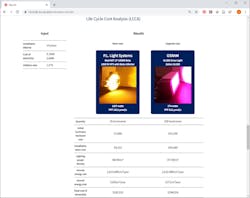LRC online calculator helps horticultural growers choose luminaires
It’s no secret that indoor farming using LED grow lights can be a costly operation. Among other reasons: As energy efficient as solid-state lighting (SSL) is compared to conventional light sources, the electricity requirements of all those hundreds or thousands of luminaires under the roof adds up.
And the lights themselves are not cheap, nor is the installation and optimization process.
Now, the Lighting Research Center (LRC) at Rensselaer Polytechnic Institute (RPI) has developed a free online calculator to help growers assess which brand and alignment of horticultural luminaires would be best for their needs, whether the growers are upgrading their facility or installing for the first time.
The LRC’s Horticulture Luminaire Calculator examines costs by prioritizing photosynthetic photon flux density (PPFD), which is a measure of how a horticultural lighting system delivers different spectra of light to the crops below.
Crops vary in their optimal PPFD requirements. Growers can use the LRC system to weigh different factors such as brands, number of luminaires, height of the lights, spacing of the lights, and other criteria in order to come up with the right combination of delivering the desired PPFD at the lowest cost. In 2018, LRC professor Mark Rea wrote an excellent Insights piece for LEDs Magazine detailing various horticultural metric considerations that debunked some conclusions reported by the US Department of Energy (DOE) relative to a study on the energy efficiency of horticultural SSL. Rea stated the LRC findings concluded that meaningful comparisons between luminaire types and characteristics include factors that can impact PPFD.
Lumen-per-watt efficiency is one of the considerations, but not the only one. “Growers can easily be misled by considering luminaire efficacy alone, when selecting lighting products for horticultural applications,” an LRC spokesperson said, regarding the calculator development. “Luminaire efficacy does not take into account important factors such as the luminaire intensity distribution, optimal luminaire layout, and the number of luminaires that will be required to reach a criterion PPFD. All of these factors are significant when evaluating the overall cost-effectiveness of various horticulture luminaire options.
“Using the calculator, growers can determine the number of each type of luminaire that will be needed to light their space to their desired light level, and select the product that will provide the optimum lighting, at the lowest cost. It would take several days to make these calculations using traditional methods. The horticulture luminaire calculator does it in a manner of minutes.”
The system lets users enter data in a “base” case scenario of one brand and compare it to an “upgrade” scenario of another. The process includes online forms for entering detailed information about many variables including the luminaires, the cost of electricity, the application including area covered, the length of intended use, the desired PPFD, and others.
Growers can obtain input information from IES files, spectral power distribution (SPD) files, and other data sources. The LRC has also pre-programmed in several reference luminaires to help start the comparison process.
The calculator returns a rich set of results. Among those, it will compare the economics of the base case versus the upgrade, and specify whether the upgrade would deliver any payback. It also specifies which of several mounting heights would be ideal for an upgrade system.
The LRC has posted written instructions for the calculator along with a video on the RPI website.
“Energy use and lifecycle costs vary widely among LED lighting systems used in controlled environment horticulture,” said LRC’s Rea. “It has been the standard approach for many years in the field of architectural lighting, and is becoming readily apparent in horticultural lighting, that we must conduct complete system energy and lifecycle cost analyses to generate an accurate picture of which technology would work best for each particular application. The horticulture luminaire calculator provides an easy way for growers to make this determination.”
The calculator works across all brands of lighting, LRC said.
On a chip level specific to one company, in early 2017 LED maker Lumileds introduced a calculator to help luminaire developers examine different mixes of the company’s Luxeon SunPlus packaged chips in order to determine horticultural-specific metrics such as photosynthetic photon flux and SPD.
Development of the LRC calculator was funded by the Lighting Energy Alliance at LRC. LEA is a collaboration of Natural Resources Canada and five other entities: Efficiency Vermont, Energize Connecticut, National Grid, Northwest Energy Efficiency Alliance, and ComEd. It aims to reduce lighting’s environmental and monetary costs.
Updates on horticultural metrics and cost analyses have been a hot topic at our HortiCann Light + Tech conferences. This year’s event is slated for Oct. 20 in San Jose, CA.
MARK HALPER is a contributing editor for LEDs Magazine, and an energy, technology, and business journalist ([email protected]).
For up-to-the-minute LED and SSL updates, why not follow us on Twitter? You’ll find curated content and commentary, as well as information on industry events, webcasts, and surveys on our LinkedIn Company Page and our Facebook page.

Mark Halper | Contributing Editor, LEDs Magazine, and Business/Energy/Technology Journalist
Mark Halper is a freelance business, technology, and science journalist who covers everything from media moguls to subatomic particles. Halper has written from locations around the world for TIME Magazine, Fortune, Forbes, the New York Times, the Financial Times, the Guardian, CBS, Wired, and many others. A US citizen living in Britain, he cut his journalism teeth cutting and pasting copy for an English-language daily newspaper in Mexico City. Halper has a BA in history from Cornell University.





